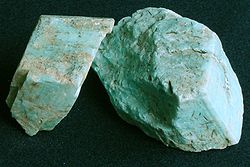| Microcline | |
|---|---|
 | |
| General | |
| Category | Tectosilicate minerals |
| Group | Feldspar group |
| Series | Alkali feldspar series |
| Formula | KAlSi3O8 |
| IMA symbol | Mcc [1] |
| Crystal system | Triclinic |
| Space group | P1 (no. 2) |
| Identification | |
| Color | White, grey, greyish yellow, yellowish, tan, salmon-pink, bluish green, green. |
| Crystal habit | Can be anhedral or euhedral. Grains are commonly elongate with a tabular appearance. May contain lamellae which formed from exsolved albite. |
| Twinning | Typically displays albite twinning and pericline twinning. This combination leads to a grid pattern, hence microcline displays gridiron twinning. Can also display carlsbad twinning, simple twins, or lack twinning altogether. Lamellae in microcline are discontinuous and "pinch and swell".  |
| Cleavage | Has perfect cleavage parallel to {001} and good cleavage on {010}. Cleavages intersect at 90°41'. It can be difficult to see cleavage in thin section due to microcline's low relief. |
| Fracture | Uneven |
| Tenacity | Brittle |
| Mohs scale hardness | 6–6.5 |
| Luster | Vitreous |
| Streak | White |
| Diaphaneity | Transparent, translucent |
| Specific gravity | 2.5–2.6 |
| Optical properties | Biaxial negative |
| Refractive index | nα = 1.514 – 1.529 nβ = 1.518 – 1.533 nγ = 1.521 – 1.539 |
| Birefringence | Up to first order white (roughly 0.007) |
| Pleochroism | N/A |
| 2V angle | 65–88° |
| Extinction | Inclined extinction to cleavage |
| Diagnostic features | Gridiron twinning distinguishes microcline from other feldspars. Distinguishable from plagioclase because the lamellae in plagioclase are continuous and do not "pinch and swell." |
| Alters to | Commonly alters to sericite or clay. |
| Relief | Low negative relief |
| Optical sign | Biaxial negative |
| Color in PPL | Colorless |
Microcline (KAlSi3O8) is an important igneous rock-forming tectosilicate mineral. It is a potassium-rich alkali feldspar. It is common in granite and pegmatites. Microcline forms during slow cooling of orthoclase. Sanidine is a polymorph of alkali feldspar stable at yet higher temperature. Microcline has cross-hatch twinning that forms as a result of the transformation of monoclinic orthoclase into triclinic microcline.
Contents
The chemical compound name is potassium aluminium silicate, and it is known as E number reference E555.
